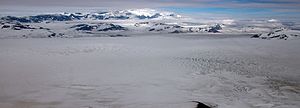Bagley Icefield facts for kids
The Bagley Icefield is a huge area of ice and snow in southeastern Alaska. It's like a giant frozen river system. It's the second largest non-polar icefield in North America. This means it's one of the biggest icefields outside of the North and South Poles!
Contents
What is the Bagley Icefield?
The Bagley Icefield is a massive sheet of ice. It covers most of the central part of the Saint Elias Mountains. It also covers part of the Chugach Mountains. This icefield is very important. It feeds many valley glaciers. These are like slow-moving rivers of ice. They flow down both sides of the mountains. Some of these glaciers include the Tana, Miles, and Guyot glaciers.
How Big is the Bagley Icefield?
The Bagley Icefield is incredibly large. It stretches about 200 kilometers (127 miles) long. It is also about 10 kilometers (6 miles) wide. In some places, the ice can be up to 1 kilometer (3,000 feet) thick! When you add the Bagley Icefield to the nearby Bering Glacier System, the total area is about 5,200 square kilometers (1,900 square miles). That's a lot of ice!
Who Was James W. Bagley?
The Bagley Icefield was named after James W. Bagley. He was an engineer who worked for the USGS. The USGS is a science agency that studies the Earth. James Bagley was a topographic engineer. This means he helped map out the land. He developed a special camera called the Bagley T-3 camera. He used it to map Alaska before World War I.
Exploring the Icefield
In the late 1800s, explorers tried to climb Mt. St. Elias. This is a very tall mountain near the icefield. One famous explorer was Luigi Amedeo, Duke of the Abruzzi. He was the first person to successfully climb Mt. St. Elias in 1897. These early explorers did not realize that the Bagley Icefield was connected. It actually forms the upper parts of the even larger Bering Glacier. The Bering Glacier had been named earlier. People had seen it from the coast.
Protecting the Bagley Icefield
The Bagley Icefield is a very special place. It is protected within the Wrangell-St. Elias National Park and Preserve. This park is one of the largest national parks in the United States. It helps keep this amazing natural wonder safe for everyone.


